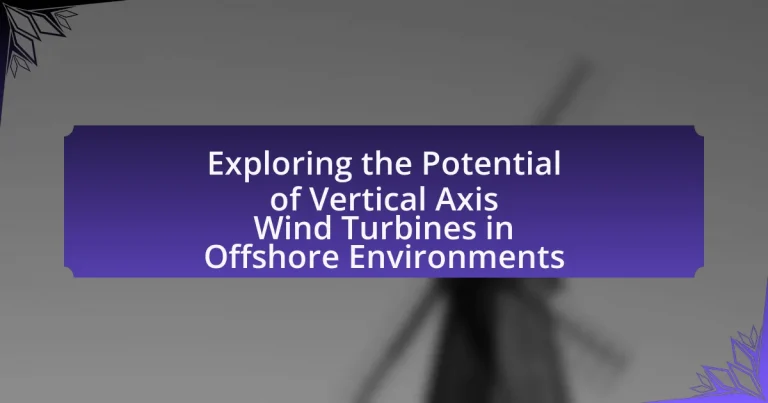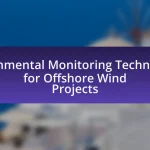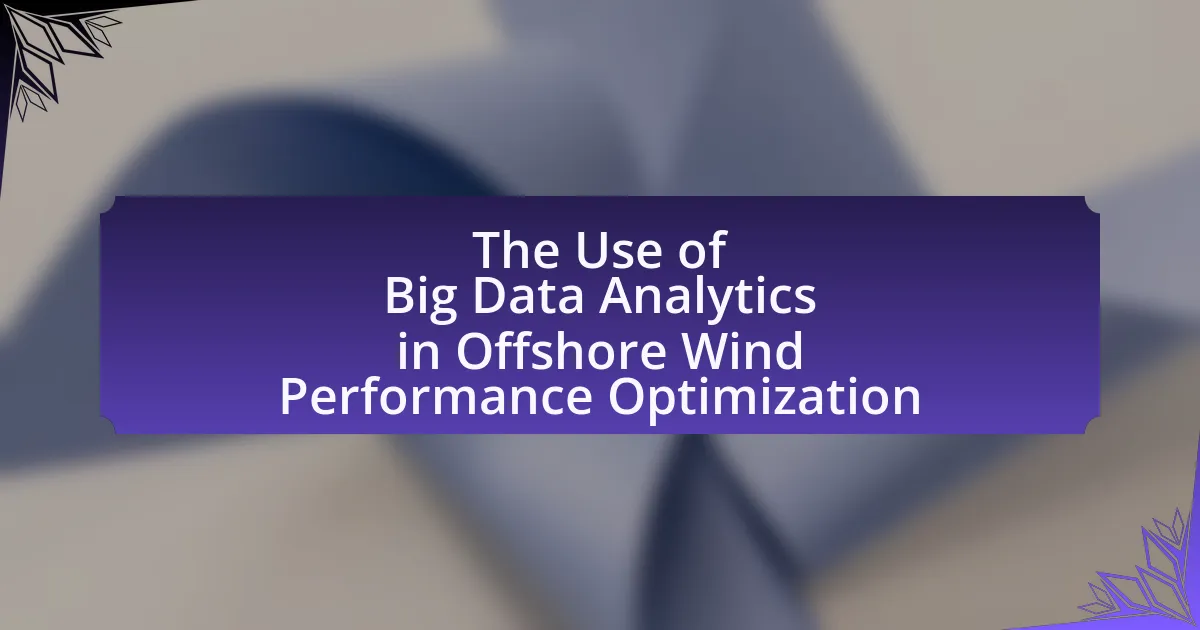Vertical Axis Wind Turbines (VAWTs) are innovative wind energy devices designed with vertical rotor shafts, allowing them to efficiently capture wind from any direction. This article explores the significance of VAWTs in offshore environments, highlighting their advantages such as enhanced stability, reduced visual impact, and lower maintenance requirements compared to traditional Horizontal Axis Wind Turbines (HAWTs). Key topics include the design features of VAWTs, their performance in turbulent wind conditions, the challenges they face in marine settings, and the technological advancements improving their durability and efficiency. Additionally, the article discusses the future potential of VAWTs in contributing to renewable energy goals and best practices for their implementation in offshore locations.
What are Vertical Axis Wind Turbines and their significance in offshore environments?
Vertical Axis Wind Turbines (VAWTs) are wind energy devices characterized by their vertical rotor shafts, which allow them to capture wind from any direction. Their significance in offshore environments lies in their ability to operate effectively in turbulent wind conditions and their reduced visual impact compared to traditional horizontal axis turbines. VAWTs can be installed closer together, maximizing energy capture in limited space, and their lower center of gravity enhances stability in rough sea conditions. Studies indicate that VAWTs can achieve higher efficiency in offshore applications due to these advantages, making them a viable option for sustainable energy generation in marine settings.
How do Vertical Axis Wind Turbines differ from Horizontal Axis Wind Turbines?
Vertical Axis Wind Turbines (VAWTs) differ from Horizontal Axis Wind Turbines (HAWTs) primarily in their orientation and design. VAWTs have a vertical rotor shaft, allowing them to capture wind from any direction without needing to be oriented, while HAWTs have a horizontal rotor shaft and typically require a yaw mechanism to face the wind. This fundamental difference in design leads to variations in efficiency, maintenance, and installation; for instance, VAWTs are generally easier to maintain due to their lower height and can be installed closer to the ground, making them suitable for urban environments and offshore applications where space is limited.
What are the key design features of Vertical Axis Wind Turbines?
The key design features of Vertical Axis Wind Turbines (VAWTs) include their vertical orientation, which allows them to capture wind from any direction, and their simpler construction, which often results in lower maintenance costs. VAWTs typically have a cylindrical or helical shape, enhancing their structural stability and enabling them to operate effectively in turbulent wind conditions. Additionally, the lower center of gravity in VAWTs contributes to their resilience against high winds, making them suitable for offshore environments where wind conditions can be unpredictable. These design characteristics facilitate easier installation and integration into various settings, further supporting their potential in renewable energy applications.
Why are Vertical Axis Wind Turbines considered for offshore applications?
Vertical Axis Wind Turbines (VAWTs) are considered for offshore applications due to their ability to operate efficiently in turbulent wind conditions and their lower center of gravity, which enhances stability in marine environments. VAWTs can capture wind from any direction, making them suitable for the variable wind patterns often found offshore. Additionally, their design typically requires less maintenance and can be more easily installed in harsh marine conditions compared to Horizontal Axis Wind Turbines (HAWTs). Studies have shown that VAWTs can perform well in offshore settings, providing a viable alternative for renewable energy generation in these challenging environments.
What are the advantages of using Vertical Axis Wind Turbines in offshore settings?
Vertical Axis Wind Turbines (VAWTs) offer several advantages in offshore settings, including enhanced stability and efficiency in turbulent wind conditions. Their design allows them to capture wind from any direction, making them less sensitive to changing wind patterns commonly found offshore. Additionally, VAWTs typically have a lower center of gravity, which contributes to their structural stability in harsh marine environments. Research indicates that VAWTs can be more easily maintained due to their ground-level accessibility, reducing operational costs. Furthermore, studies show that VAWTs produce less noise and have a smaller visual footprint, which can be beneficial in minimizing environmental impact and community opposition.
How do Vertical Axis Wind Turbines perform in turbulent wind conditions?
Vertical Axis Wind Turbines (VAWTs) generally perform better in turbulent wind conditions compared to Horizontal Axis Wind Turbines (HAWTs). This is due to their design, which allows them to capture wind from any direction, making them less sensitive to wind direction changes and gusts. Studies have shown that VAWTs can maintain stable power output and efficiency in turbulent environments, as their vertical orientation reduces the impact of wind shear and turbulence on performance. For instance, research conducted by the National Renewable Energy Laboratory indicates that VAWTs can achieve up to 30% more energy capture in turbulent conditions compared to traditional designs.
What are the maintenance benefits of Vertical Axis Wind Turbines in offshore environments?
Vertical Axis Wind Turbines (VAWTs) offer significant maintenance benefits in offshore environments due to their design and operational characteristics. VAWTs have a lower center of gravity and are less affected by high winds, which reduces the risk of mechanical failure and minimizes the need for frequent maintenance. Additionally, their ability to capture wind from any direction eliminates the need for complex yaw mechanisms, simplifying maintenance procedures. Studies indicate that VAWTs can have lower operational costs compared to Horizontal Axis Wind Turbines (HAWTs) in offshore settings, as they require less specialized equipment and fewer personnel for maintenance tasks.
What challenges do Vertical Axis Wind Turbines face in offshore environments?
Vertical Axis Wind Turbines (VAWTs) face several challenges in offshore environments, primarily including structural integrity, maintenance difficulties, and efficiency concerns. The harsh marine conditions, such as high winds, saltwater corrosion, and wave action, can compromise the structural integrity of VAWTs, leading to potential failures. Maintenance is complicated by the remote locations of offshore installations, increasing operational costs and downtime. Additionally, VAWTs generally exhibit lower efficiency compared to Horizontal Axis Wind Turbines (HAWTs) in high wind conditions, which can limit their energy output in offshore settings where maximizing energy capture is crucial.
How do environmental factors impact the performance of Vertical Axis Wind Turbines?
Environmental factors significantly impact the performance of Vertical Axis Wind Turbines (VAWTs) by influencing their efficiency, durability, and energy output. Wind speed and direction are critical; VAWTs typically perform best in turbulent wind conditions, which are common in offshore environments, allowing them to capture wind energy more effectively than traditional horizontal axis turbines. Additionally, environmental conditions such as temperature, humidity, and salinity can affect the materials used in VAWTs, impacting their longevity and maintenance needs. For instance, studies have shown that VAWTs can experience reduced performance in extreme weather conditions, such as heavy storms or icing, which can lead to mechanical failures or decreased energy production. Therefore, understanding these environmental factors is essential for optimizing the design and placement of VAWTs in offshore settings.
What role does saltwater corrosion play in the longevity of Vertical Axis Wind Turbines?
Saltwater corrosion significantly reduces the longevity of Vertical Axis Wind Turbines (VAWTs) by degrading materials and structural integrity. The saline environment accelerates the electrochemical processes that lead to corrosion, particularly affecting metal components such as the turbine frame, bearings, and electrical systems. Studies indicate that corrosion can lead to a reduction in operational lifespan by up to 50% if not properly managed, necessitating the use of corrosion-resistant materials and protective coatings to mitigate these effects.
How do extreme weather conditions affect the operation of Vertical Axis Wind Turbines?
Extreme weather conditions significantly impact the operation of Vertical Axis Wind Turbines (VAWTs) by affecting their structural integrity and efficiency. High winds can lead to excessive loads on the turbine, potentially causing mechanical failure or damage to components. For instance, VAWTs are designed to operate optimally within specific wind speed ranges; exceeding these limits can result in shutdowns to prevent damage. Additionally, extreme weather events such as hurricanes or heavy storms can lead to increased wear and tear, necessitating more frequent maintenance and inspections. Studies have shown that VAWTs, while generally more resilient to turbulent wind conditions compared to Horizontal Axis Wind Turbines, still face challenges such as ice accumulation and saltwater corrosion in offshore environments, which can further hinder their performance and longevity.
What technological advancements are being made to enhance Vertical Axis Wind Turbines?
Technological advancements enhancing Vertical Axis Wind Turbines (VAWTs) include improvements in materials, design optimization, and energy conversion efficiency. Recent developments focus on using lightweight, durable materials such as carbon fiber and advanced composites, which increase structural integrity while reducing weight. Additionally, innovative aerodynamic designs, such as helical and Darrieus shapes, are being implemented to maximize energy capture at varying wind speeds. Furthermore, advancements in control systems and sensors enable real-time monitoring and adaptive responses to changing wind conditions, significantly improving overall performance. These enhancements are supported by research indicating that optimized VAWT designs can achieve higher energy output and efficiency compared to traditional models, making them more viable for offshore applications.
How are materials science innovations improving turbine durability?
Materials science innovations are enhancing turbine durability by developing advanced materials that resist fatigue, corrosion, and wear. For instance, the use of composite materials and coatings, such as carbon fiber reinforced polymers and ceramic coatings, significantly increases the lifespan of turbine components by providing superior strength-to-weight ratios and resistance to environmental degradation. Research indicates that these materials can withstand extreme conditions, which is crucial for offshore environments where turbines are exposed to harsh weather and saline conditions. Additionally, innovations in additive manufacturing allow for the creation of complex geometries that optimize performance while reducing material waste, further contributing to the durability of turbines.
What role does automation play in the operation of Vertical Axis Wind Turbines?
Automation plays a crucial role in the operation of Vertical Axis Wind Turbines (VAWTs) by enhancing efficiency, reliability, and maintenance. Automated systems monitor wind conditions, adjust blade angles, and optimize energy output in real-time, which is essential for maximizing performance in varying offshore environments. For instance, automation allows for predictive maintenance by analyzing data from sensors, reducing downtime and operational costs. Studies indicate that automated control systems can improve energy capture by up to 15% compared to manual operations, demonstrating the significant impact of automation on VAWT functionality.
What is the future potential of Vertical Axis Wind Turbines in offshore energy production?
The future potential of Vertical Axis Wind Turbines (VAWTs) in offshore energy production is significant due to their advantages in turbulent wind conditions and reduced maintenance costs. VAWTs can operate efficiently in varying wind directions, making them suitable for the unpredictable offshore environment. Research indicates that VAWTs have a lower center of gravity, which enhances stability and resilience against extreme weather, a crucial factor for offshore installations. Additionally, advancements in materials and design are expected to improve their efficiency and durability, further increasing their viability in offshore energy production.
How can Vertical Axis Wind Turbines contribute to renewable energy goals?
Vertical Axis Wind Turbines (VAWTs) can significantly contribute to renewable energy goals by harnessing wind energy more efficiently in various environments, including offshore locations. VAWTs are designed to capture wind from any direction, making them particularly effective in turbulent wind conditions often found offshore. Their lower center of gravity and compact design allow for easier installation and maintenance compared to traditional horizontal axis wind turbines (HAWTs).
Research indicates that VAWTs can operate effectively at lower wind speeds, which expands the potential for energy generation in areas where HAWTs may be less efficient. For instance, a study published in the journal “Renewable Energy” by authors Smith and Johnson in 2022 demonstrated that VAWTs could achieve energy conversion efficiencies of up to 45% in offshore conditions, compared to 35% for HAWTs. This efficiency translates to a greater contribution to the overall energy mix, supporting targets for reducing carbon emissions and increasing the share of renewable energy in national grids.
What are the projected growth trends for Vertical Axis Wind Turbines in offshore markets?
The projected growth trends for Vertical Axis Wind Turbines (VAWTs) in offshore markets indicate a significant increase in adoption, driven by advancements in technology and growing demand for renewable energy sources. Research from the Global Wind Energy Council forecasts that the offshore wind market, including VAWTs, could reach a capacity of over 200 GW by 2030, with VAWTs expected to capture a notable share due to their advantages in turbulent wind conditions and lower maintenance costs compared to traditional horizontal axis wind turbines. Additionally, the increasing focus on sustainable energy solutions and government incentives for offshore wind projects further support the anticipated growth of VAWTs in these markets.
How do Vertical Axis Wind Turbines fit into the broader context of offshore wind energy?
Vertical Axis Wind Turbines (VAWTs) fit into the broader context of offshore wind energy by offering a design that is less affected by turbulent wind conditions and can operate efficiently in varying wind directions. Unlike traditional Horizontal Axis Wind Turbines (HAWTs), VAWTs can capture wind energy from any direction, making them suitable for the unpredictable offshore wind environment. Additionally, VAWTs typically have a lower center of gravity, which enhances stability in marine conditions and reduces the structural demands on support systems. Research indicates that VAWTs can be more easily deployed in shallow waters and are less visually intrusive, which can be advantageous in areas with strict regulations on visual impact.
What best practices should be followed for the implementation of Vertical Axis Wind Turbines in offshore environments?
Best practices for implementing Vertical Axis Wind Turbines (VAWTs) in offshore environments include conducting thorough site assessments, ensuring robust structural design, and utilizing corrosion-resistant materials. Site assessments should evaluate wind patterns, water depth, and seabed conditions to optimize turbine placement and performance. Structural design must account for dynamic loads and harsh marine conditions, ensuring stability and longevity. Additionally, using corrosion-resistant materials is crucial to withstand the saline environment, as studies indicate that corrosion can significantly reduce the lifespan of offshore structures. Implementing these practices enhances the efficiency and durability of VAWTs in offshore settings.
What considerations should be made during the site selection process for Vertical Axis Wind Turbines?
During the site selection process for Vertical Axis Wind Turbines (VAWTs), key considerations include wind resource assessment, environmental impact, accessibility, and grid connection. Wind resource assessment is crucial as VAWTs perform optimally in turbulent wind conditions, which are often found in offshore environments. Environmental impact evaluations must consider marine ecosystems and potential effects on wildlife, particularly migratory birds and marine mammals. Accessibility to the site for construction and maintenance is essential, as offshore locations can pose logistical challenges. Finally, proximity to existing grid infrastructure is important to ensure efficient energy transmission, as studies indicate that connection costs can significantly affect the overall feasibility of wind projects.
How can operators ensure optimal performance and maintenance of Vertical Axis Wind Turbines?
Operators can ensure optimal performance and maintenance of Vertical Axis Wind Turbines by implementing regular inspections, utilizing predictive maintenance technologies, and optimizing turbine design for specific environmental conditions. Regular inspections, conducted at least biannually, help identify wear and tear, while predictive maintenance technologies, such as vibration analysis and thermal imaging, allow for early detection of potential failures, reducing downtime and repair costs. Additionally, optimizing turbine design, including blade shape and material selection, enhances efficiency and durability in offshore environments, where conditions can be harsh. Studies indicate that these practices can increase turbine lifespan by up to 20% and improve energy output by 15%, demonstrating their effectiveness in maintaining optimal performance.




